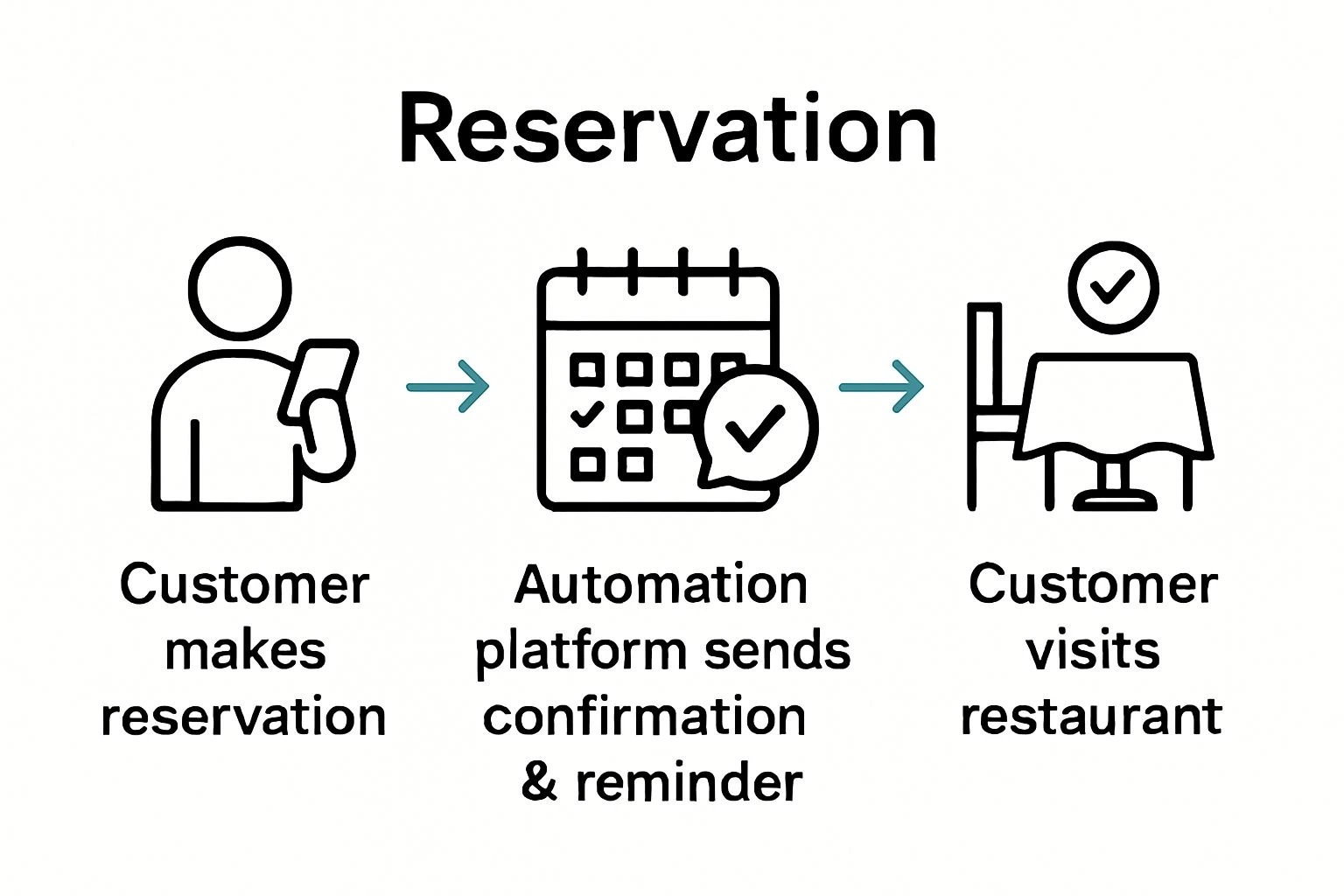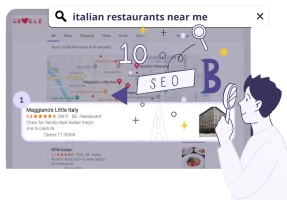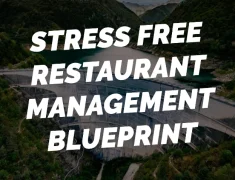Restaurant owners spend hours chasing after bookings and juggling guest messages, but even with all that effort most places still lose revenue to no-shows and clumsy manual follow-ups. Here is a surprising fact. Restaurants that automate their communications can reduce no-show rates by up to 30 percent and see booking conversions rise dramatically. Many assume automation is all about fancy tech, but the real magic lies in spotting the hidden gaps in your current strategy before a single tool is plugged in.
Table of Contents
Step 1: Assess Your Current Marketing Strategy
Market strategy assessment forms the foundational groundwork for successful restaurant marketing automation. Before diving into sophisticated tools and technologies, you need a clear snapshot of your current marketing performance and potential growth areas. Begin by conducting a comprehensive audit of your existing marketing channels and performance metrics. This means reviewing your digital footprint across social media platforms, email marketing campaigns, website engagement, and traditional marketing efforts. Collect data on customer interaction rates, booking conversions, engagement levels, and revenue generation from each channel. Analyze your current customer communication strategies. Examine how you currently manage reservations, handle customer inquiries, and track guest preferences. Look for bottlenecks or manual processes that consume significant staff time. Key areas to scrutinize include booking confirmation methods, reminder systems, and guest follow-up protocols. Identify key performance indicators (KPIs) that matter most to your restaurant. These might include booking conversion rates, no-show percentages, average table turnover time, and customer retention metrics. Understanding these numbers will help you determine where marketing automation can deliver maximum impact.
This table outlines recommended core tools and resources mentioned for conducting an initial marketing strategy assessment, including their specific roles within the evaluation process.
Tool/Resource | Purpose | Example Use |
Google Analytics | Website performance tracking | Measure website visits, booking flow, and user engagement |
Social Media Platform Analytics | Assess social engagement and reach | Review post performance, follower growth, and interactions |
CRM System | Customer data management and tracking | Monitor guest preferences, reservation history, and segmentation |
Spreadsheet Templates | Manual data compilation and auditing | Organise raw metrics from multiple sources for analysis |
Explore our guide on boosting restaurant revenue through strategic analytics to gain deeper insights into performance measurement. This assessment stage is not about perfection but understanding your current operational landscape.
Recommended assessment tools and resources include:
Google Analytics for website performance tracking
Social media platform native analytics
Customer relationship management (CRM) systems
Spreadsheet templates for manual data compilation
Once you have compiled your current marketing performance data, you will be well-positioned to identify precise automation opportunities that can streamline operations and enhance guest experiences.
Below is an overview table summarising each main step of the restaurant marketing automation process, along with suggested key outcomes for every stage.
Step | Description | Key Outcome |
Assess Current Marketing | Audit all marketing channels, analyse communications, and identify KPIs | Opportunity areas for automation discovered |
Choose Automation Tools | Evaluate and select platforms to match operational needs and integration ease | Appropriate, cost-effective tool selected |
Set Up Automated Campaigns | Segment customer base and design targeted, automated communication workflows | Enhanced personalisation and engagement |
Integrate Systems | Connect reservation, CRM, and marketing platforms for seamless data flow | Streamlined, error-reduced workflow |
Test Automation Performance | Monitor regular performance metrics, run A/B tests, and evaluate results | Ongoing optimisation and efficiency |
Analyse and Adjust Strategies | Aggregate data, compare against baselines, and refine tactics as needed | Improved campaign effectiveness and ROI |
Step 2: Choose the Right Automation Tools
Selecting appropriate marketing automation tools represents a critical decision that can transform your restaurant’s operational efficiency and guest engagement strategy. Your goal is to find solutions that seamlessly integrate with your existing systems while addressing the specific challenges uncovered during your initial assessment.
Start by evaluating restaurant marketing automation platforms that offer comprehensive features tailored to hospitality businesses. Look for tools that provide integrated reservation management, customer communication workflows, analytics tracking, and multi-channel engagement capabilities. Your chosen platform should reduce manual administrative tasks while enhancing guest experience and operational insights.
Consider the scalability and flexibility of potential automation solutions. A robust system should adapt to your restaurant’s unique requirements, whether you operate a small bistro or manage multiple dining establishments. Prioritize platforms that offer customisable booking forms, automated communication triggers, and intuitive dashboard interfaces that enable quick performance monitoring.
Discover strategies for boosting restaurant revenue through strategic analytics to understand how advanced tools can transform your marketing approach. When evaluating potential automation platforms, focus on key evaluation criteria:
Comprehensive integration capabilities
Real-time reporting and analytics
Automated marketing communication features
User-friendly interface
Pricing structure alignment with your budget
Evaluate each potential tool through comprehensive demonstrations and trial periods. Request detailed walkthroughs that showcase specific features relevant to restaurant marketing. Pay close attention to the platform’s ability to streamline reservation management, reduce no-show rates, and provide actionable guest insights. Remember that the most expensive solution is not always the best fit. Prioritise tools that offer the most relevant features for your specific restaurant’s needs while maintaining a balance between functionality and cost-effectiveness. A well-chosen automation platform will ultimately save time, reduce operational stress, and create more meaningful guest interactions.
Step 3: Set Up Automated Campaigns
Automated marketing campaigns represent a powerful strategy for restaurant engagement, transforming how you communicate with guests and drive repeat business. After selecting your automation platform, the next critical step involves designing targeted campaigns that resonate with your specific customer segments. Segment your customer database strategically, creating distinct groups based on dining preferences, frequency of visits, average spend, and previous interaction history. This granular approach allows for personalised communication that feels more authentic and compelling. For instance, create separate campaign streams for first-time guests, loyal regulars, weekend diners, and special occasion visitors.
Learn how to build an effective restaurant email marketing list to support your automated campaign strategy. Develop a comprehensive communication workflow that includes multiple touchpoints such as reservation confirmations, birthday offers, post-dining feedback requests, and seasonal promotions.
Design campaign sequences that provide genuine value to your guests. Craft automated messages that feel personal and timely, not generic or intrusive**. This might include welcome emails for new guests, personalised birthday discounts, loyalty programme updates, and exclusive event invitations.

Key campaign types to implement:
Reservation confirmation and reminder sequences
Post-dining feedback and review requests
Loyalty programme engagement communications
Seasonal and holiday special promotions
Implement sophisticated triggers that activate specific campaign sequences based on customer actions. For example, a guest who makes a reservation during a slow weeknight might automatically receive a special midweek dining discount. Similarly, customers who haven’t visited in several months could be re-engaged with a personalised “we miss you” communication. Carefully monitor campaign performance metrics such as open rates, click-through rates, and conversion percentages. Be prepared to continuously refine your approach, testing different messaging, timing, and offer structures to optimise engagement and effectiveness.
Step 4: Integrate Your Systems for Seamless Workflow
System integration represents the critical backbone of effective restaurant marketing automation, transforming disconnected tools into a powerful, cohesive operational ecosystem. Your goal is to create a seamless workflow where customer data, reservation systems, communication platforms, and marketing tools communicate effortlessly, reducing manual intervention and minimising potential errors.
Begin by mapping out all existing technological touchpoints within your restaurant operations. This includes point-of-sale systems, reservation platforms, customer relationship management software, email marketing tools, and social media channels. Understanding the current technological landscape will help you identify integration opportunities and potential bottlenecks.
Explore our comprehensive guide on restaurant email marketing strategies to understand how integrated systems can enhance communication efficiency. Focus on selecting automation platforms that offer robust API connections and native integration capabilities. Look for solutions that can synchronise customer data across multiple platforms in real-time, ensuring consistency and accuracy. Implement a centralised data management approach where guest information is automatically updated and shared across different systems. This means when a customer makes a reservation, their details should be instantly reflected in your marketing database, loyalty programme, and communication channels. Such seamless integration eliminates redundant data entry and provides a holistic view of each guest’s interactions with your restaurant.
Key integration priorities include:
Reservation system synchronisation
Automatic customer profile updates
Real-time booking and communication tracking
Unified customer interaction history
Consistent data management across platforms
Consider working with technical specialists or your chosen automation platform’s support team to ensure smooth system connections. Some platforms offer pre-built integrations, while others might require custom API development. Prioritise solutions that provide user-friendly integration processes and comprehensive technical support. Test your integrated systems thoroughly, verifying data accuracy, synchronisation speed, and overall performance. Regularly audit your workflow to identify potential improvements and ensure that your technological ecosystem continues to meet your restaurant’s evolving operational needs.
Step 5: Test Automation Performance Regularly
Regular performance testing is the linchpin of maintaining an effective restaurant marketing automation strategy. Without consistent evaluation, even the most sophisticated systems can become inefficient or misaligned with your business objectives. Your goal is to create a systematic approach to monitoring, analysing, and refining your automated marketing processes.
Establish a comprehensive performance tracking framework that goes beyond surface-level metrics. This means diving deep into both quantitative and qualitative data points that reveal the true impact of your automation efforts. Track key performance indicators such as booking conversion rates, customer engagement levels, campaign response rates, and revenue attributed to automated marketing initiatives. Discover strategies for boosting restaurant revenue through strategic analytics to understand the nuanced approach to performance measurement. Implement a regular testing schedule that includes monthly comprehensive reviews and weekly quick performance checks. During these evaluations, examine the entire customer journey, from initial contact through reservation and post-dining communication. Create controlled experiments to identify optimization opportunities. This might involve A/B testing different messaging approaches, timing of communications, or promotional offers. For instance, compare the performance of two different birthday offer campaigns or test variations in reservation reminder messages to determine which generates better engagement and conversion rates.
Critical areas to focus on during performance testing:
Campaign response and conversion rates
Customer engagement metrics
Automated communication effectiveness
System integration performance
Revenue impact of marketing automation
Develop a feedback loop that allows for rapid adjustments. When testing reveals underperforming elements, create a structured process for implementing improvements. This might involve collaborating with your automation platform’s support team, consulting with marketing specialists, or conducting direct customer surveys to gain deeper insights. Remember that performance testing is not a one-time activity but an ongoing process of continuous improvement. Stay agile, be willing to experiment, and maintain a data-driven approach to refining your restaurant marketing automation strategy. The most successful implementations are those that evolve continuously in response to changing customer preferences and technological capabilities.
Step 6: Analyse Results and Adjust Strategies
Analysing marketing automation results is a nuanced process that transforms raw data into actionable strategic insights for your restaurant. This critical step moves beyond simple number crunching, requiring a holistic approach to understanding how your automated marketing efforts translate into tangible business outcomes.
Develop a comprehensive dashboard that aggregates performance metrics from multiple channels, creating a unified view of your marketing automation ecosystem. Focus on metrics that directly impact restaurant performance, such as booking conversion rates, customer acquisition costs, repeat visit frequencies, and revenue per marketing campaign. Look for patterns that reveal deeper insights about guest behaviour and campaign effectiveness.
Learn how to analyse marketing data with precision to enhance your strategic decision-making process. Begin by comparing current performance against your initial baseline established during the assessment phase. Identify which automated campaigns generate the highest return on investment, paying special attention to metrics like engagement rates, conversion percentages, and direct revenue attribution.

Segment your analysis across different customer groups and campaign types. This granular approach helps you understand how various marketing automation strategies perform for different dining segments. For instance, examine how birthday promotions work for weekend diners versus weekday lunch crowds, or compare the effectiveness of special occasion campaigns across different age groups.
Key analysis focus areas:
Campaign-specific conversion rates
Customer segment performance
Revenue generated per marketing initiative
Guest retention and repeat visit metrics
Cost-effectiveness of automation strategies
Create a structured approach to strategic adjustment. When certain campaigns or channels underperform, develop hypotheses about potential improvements. This might involve tweaking messaging, adjusting send times, refining audience segmentation, or redesigning promotional offers. Implement changes incrementally, always maintaining a data-driven perspective that allows for precise, measurable refinements.Remember that marketing automation analysis is an ongoing journey of continuous improvement. Stay curious, remain flexible, and view each data point as an opportunity to better understand and serve your restaurant guests more effectively.
Turn Restaurant Marketing Automation into Real Results – See How Tableo Streamlines Success
If you have been frustrated by patchy booking processes, mounting no-shows, and disconnected guest data, this is your moment for change. The article highlighted how effective marketing automation resolves common headaches such as manual admin, inconsistent customer communications, and wasted opportunities for guest engagement. Tableo takes these solutions further, giving you practical tools like digital floor plans, unified guest profiles, and AI-powered messaging to instantly simplify your daily operations and boost customer retention.
Ready to shift from analysis to action? Join hundreds of successful establishments that have automated their booking management and strengthened their guest experience with Tableo. You can effortlessly take your campaigns to the next level and enable seamless integration across all touchpoints. Do not let your competitors outpace you – visit Tableo’s homepage now and start transforming your restaurant’s marketing automation before another busy night passes you by.
Frequently Asked Questions
How can I assess my current marketing strategy for restaurant automation?
To assess your current marketing strategy, conduct a comprehensive audit of all your existing marketing channels, including social media, email campaigns, and website engagement. Gather data on customer interactions and performance metrics to identify areas for improvement before implementing automation.
What are the key features to look for in restaurant marketing automation tools?
When selecting marketing automation tools, focus on features like integrated reservation management, customer communication workflows, and analytics tracking. Prioritise platforms that reduce manual tasks and enhance guest engagement, aiming to streamline operations within your restaurant.
How do I set up automated marketing campaigns tailored to my restaurant guests?
To set up automated campaigns, segment your customer database based on dining preferences and visit history. Design personalised communication workflows that include booking confirmations and special promotions to engage your guests effectively.
What systems should I integrate for a seamless workflow in restaurant marketing?
Integrate systems like your point-of-sale, reservation platforms, and email marketing tools to create a cohesive operational ecosystem. By ensuring these systems communicate effectively, you’ll reduce manual errors and provide a more streamlined guest experience.
How often should I test the performance of my restaurant marketing automation?
Regularly test your automation performance by establishing a monthly review schedule while conducting quick weekly checks. Focus on key metrics such as conversion rates and customer engagement to continually optimise your marketing strategies.
What metrics should I analyse to adjust my restaurant marketing automation strategies?
Analyse metrics such as booking conversion rates, customer retention rates, and revenue attributed to marketing campaigns. This will help you identify which strategies are effective and inform necessary adjustments to improve performance.

Unlock the tips that will help you stand out from the crowd and get more bookings!

Learn how to save time, reduce stress and fill your restaurant while you sleep!

Stephanie Paris
Gen-Z marketing coordinator bringing fresh energy to web and graphic design, with a weekend habit of chasing adventure.









